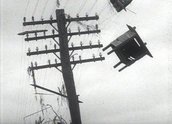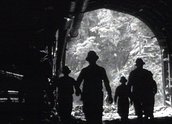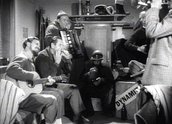


The Forerunner (1957)
Synopsis
Made by the Shell Film Unit within the first decade of the Snowy Mountains Hydro-electric Scheme’s construction, this documentary positions the ambitious scheme as the country’s 'first major step towards the final solution of Australia’s water problem’.
Curator’s notes
An intriguing documentary both for its style and poetic imagery, The Forerunner continues the Shell Company of Australia’s interest in producing films about the country’s natural resources and environment.
The first two-thirds of this documentary set the context for the scheme by showing the uneven pattern of flood and drought across the country. In a series of emotive and extended sequences of up to ten minutes in length, these scenes contain no narration but often a haunting melody which floats over the soundtrack. These flood and drought scenes are filled with potent imagery which focuses on objects – a kitten, a shoe, a pram, a sheep, a fence, an animal skeleton, a tin roof – which sum up the impact of these natural disasters and create empathy in the viewer.
The final third of the film shows work on the scheme itself using similar symbolic imagery, including a pair of skis pitched in the snow, a frog perched on a rock, a clothes line buried in snow, a silhouette of tunnel workers. Again, these extended sequences use little narration, and the final scene takes place inside the workers’ hut where they gather for a song. The only intrusion of instructional or educational content in the film comes through two brief scenes when civil engineer Professor CH Munro explains, in an address to camera, the detail and scale of the scheme with the aid of illustrations and maps. Overall, The Forerunner is a powerful documentary that stands in contrast to the more informational documentaries produced by the Snowy Mountains Hydro-electric Authority, a selection of which are also on this website.
The Shell Film Unit Australia was one of Australia’s most accomplished documentary film units working in the 1940s and 1950s. Both the film’s director John Heyer and one of its cinematographers Ross Wood had previously worked with the Department of Information’s Commonwealth Film Unit and their technical and storytelling skills are evident here. The influence of the British documentary movement and filmmakers like John Grierson can be also seen in parts of The Forerunner and in the 1954 classic The Back of Beyond.
- Overview
- Curator’s notes
- Video 3 clips

- Principal credits
- Find a copy
- Comments 2
- Map
- Add your review



